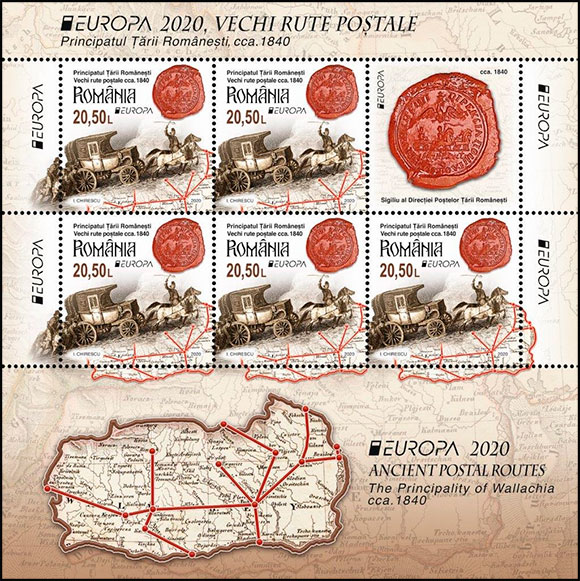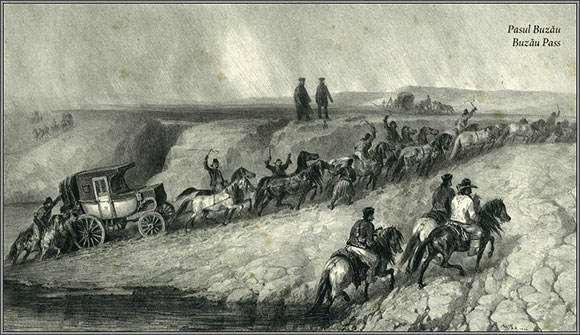
On April 9, 2020, the Romanian Post issued two postage stamps as part of the Europe series dedicated to Ancient Postal Routes.
In the Romanian principalities in the 17th-18th centuries, a state postal service functioned, however, with the permission of the prince, individuals could also use the postal transport. At the beginning of the 19th century, post stations called menziluri were organized, led by a menzil captain. There were kept horses and carriages necessary for couriers and officials traveling at the direction of the prince. All of them had to have a road trip, which indicated the route, the number of horses required for the trip and other information. The chiefs of post stations had special seals bearing the name of the post office. In 1830, fixed postage rates were introduced in the Romanian principalities, the cost depended on the type of postal services, route and distance. Each post station along the route had to have 20 horses, and the stable had to accommodate at least 30 horses. Since 1851, a regular movement of stagecoaches began to deliver mail, newspapers, various goods and passengers.
At that time, the main postal roads in Wallachia were the following routes: Bucharest-Targovishte, Bucharest-Craiova, Bucharest-Giurgiu or Silistra, through the Balkans to Adrianople and Constantinople, and in Moldova: Yassy-Barlad-Galati-Sumla, through the Balkans to Adrianople and Constantinople Yassy-Harlau-Chernauti. Secondary roads branched off from the main post roads, providing the territory of the Romanian principalities with regular postal services.
The postage stamp with a denomination of 1.90 lei depicts postal couriers and the stamp of the Roman post station from 1840; the background is a map of Moldova showing the main postal routes. A postage stamp with a face value of 20.50 lei depicts a postal carriage and the stamp of a post office in Wallachia, with a map of the network of postal roads in the principality in the background.

In the design of postage stamps, the artist Ion Chirescu used lithographs by the French artist Auguste Raffet. It was published in a 4-volume work by A.N. Demidov's "Travel to Southern Russia and Crimea through Hungary, Wallachia, Moldavia." In 1837, the Russian prince Anatoly Nikolaevich Demidov organized a research expedition to the southern provinces of Russia and Crimea. On the way to the Crimea from Paris and Vienna, the expedition members traveled through several Romanian provinces - Wallachia, Moldavia, Banatu and Bessarabia. The first volume contains numerous information about the territory, history and life in the Romanian principalities and is considered one of the richest documentary sources on the history of that period. The rest of the volumes are devoted to the South of Russia and the Crimea.
Among the participants of the expedition was the French artist Auguste Raffet, who made numerous sketches of landscapes, people, and everyday scenes from life throughout the trip. The edition, published in Paris in 1840, includes more than 100 of his lithographs with captions to the drawings, among them the "Crossing to Buzău (Wallachia), July 17, 1837" Fragments of this particular drawing were used in the design of new postage stamps.

This issue of stamps comes in a wide variety of formats. In addition to the postage stamps, two miniature sheets of four stamps (2x2) were issued, containing all the stamps of the series, as well as two sheets of 5 stamps of each denomination with a coupon. The postage stamps were printed on sheets of 27 stamps + a coupon, in such a way that numerous tete-beshes were formed in different combinations. A booklet with a miniature sheet of 2 stamps without perforation was also issued.

Перейти в каталог


